





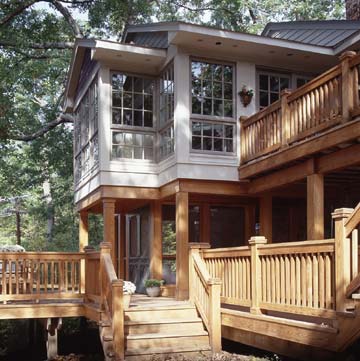 With good design and
craftsmanship, a deck can be an
elegant addition to the home
and landscape.
With good design and
craftsmanship, a deck can be an
elegant addition to the home
and landscape.
When deciding where to put a deck, you don't have to settle for the obvious. Although a deck is an ideal way to create a level outdoor area on a sloping site, you can also build a deck on level ground. In most cases, decks can be built just about anywhere you would build a patio.
A deck can create an entry area. It can be a small, intimate space adjoining a bedroom or study. Or it can follow the typical model and be joined to the back of the house, with access from either the kitchen or family room. You can also build a freestanding deck in a remote area of the garden.
An Economical Front Yard Landscape Plan
continue reading below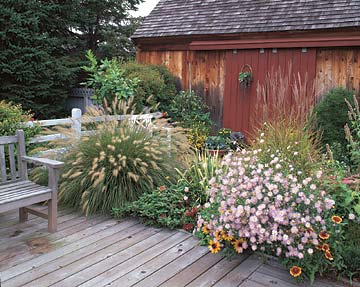 Surrounded by plants, a low
deck blends into the
landscape, seeming to hover
just above the garden.
Surrounded by plants, a low
deck blends into the
landscape, seeming to hover
just above the garden.
Wherever you decide to site your deck (or decks), be sure to think about the practical uses you want to achieve (like entertaining or private relaxing) rather than imagining some idealized situation that will likely never come to pass.
Garden for a Deck
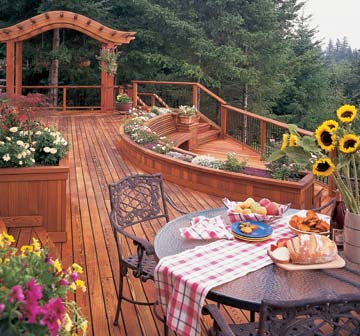 If your home is built on steep
terrain, chances are you have
at least one good view. A deck
is a good way to take advantage
of it.
If your home is built on steep
terrain, chances are you have
at least one good view. A deck
is a good way to take advantage
of it.
By far, most decks are attached to the rear of the house. This makes them true extensions of the home. Ideally, there is access from more than one room as well as the garden. As an extension of the home, decks take their design cues from it in materials, colors, and overall style.
Decks can be used for just about any purpose -- entertaining, cooking, dining, gardening, or relaxing. Knowing how you intend to use the deck is helpful in designing the right structure.
Designing for Outdoor Living
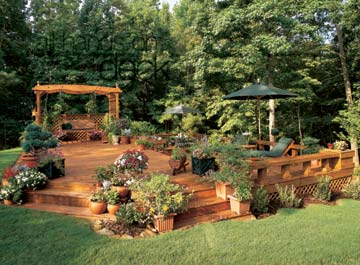 Attention to detail makes a big
difference. Here, perimeter
benches, an arbor-covered
swing, and coordinating
planters create a unified,
pleasing look.
Attention to detail makes a big
difference. Here, perimeter
benches, an arbor-covered
swing, and coordinating
planters create a unified,
pleasing look.
If you plan to use the deck for large gatherings, estimate the number of people and include that information when designing the infrastructure. If you're building the deck yourself, check local building codes, regulations, and zoning restrictions. Height limits, overhead structures, construction parameters, and even where you can build this type of structure may be dictated by these rules.
Wood decks tend to have a softer, more casual effect on the landscape than patios built more formally of masonry such as bricks and mortar. They may also be much less costly to construct.
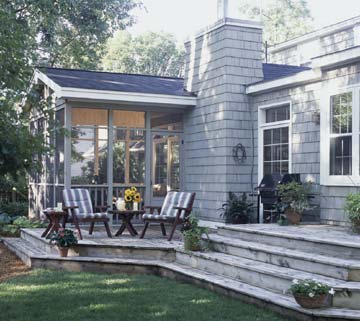 To help link the deck to the
rest of the garden, use steps
that are wide enough to allow
easy access and an open view.
To help link the deck to the
rest of the garden, use steps
that are wide enough to allow
easy access and an open view.
One of the strongest points about a deck is that it can make use of an otherwise difficult site. Building a deck over steeply sloping terrain is usually easier and less expensive than terracing the area. Because decks typically place you above the level of the surrounding land, they can command views of your property and beyond. The steeper the terrain, the higher the deck will be off the ground; planning one calls for professional advice. Seek the counsel you need to be sure your structure is safe and enduring.
If you inherited a patio that is in poor shape, consider building a deck that sits just above the old concrete.
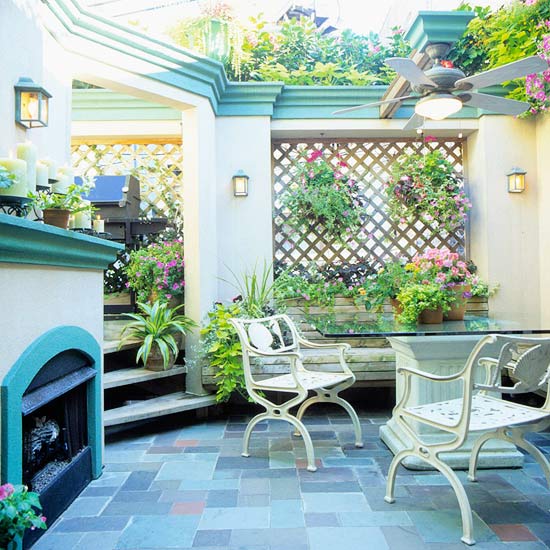 A patio that is a few steps down
from a deck makes a pleasant
transition from house to garden.
A patio that is a few steps down
from a deck makes a pleasant
transition from house to garden.
Decks seem an extension of the house, even those that are not literally attached to it. Patios seem more a part of the garden. This is partly due to their height. Decks are usually built just below the floor level of the house, whereas patios are built at ground level (or even below it).
Just as a patio that is adjacent to the house serves as a transition area between the house and garden, a deck plays the same role. Taking the idea of transition one step further, consider having a deck that is attached to the house, stepping down to a patio. This creates a gradual movement from the completely controlled environment of the home to a wood-surfaced outdoor room next to the house to a stone-surfaced, ground-level room adjacent to or surrounded by the garden. If you're building a combination deck and patio, pay attention to where the two features meet. The union should be stable and safe, and the materials should match or blend.
Depending on how you plan to use your outdoor rooms, a combination deck and patio may turn out to provide one space used primarily as a sitting room and one dedicated to outdoor cooking and dining.
Copyright © www.100flowers.win Botanic Garden All Rights Reserved